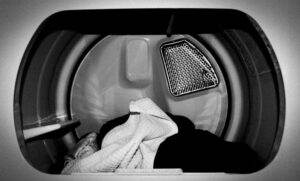Washer troubleshooting is an essential skill for any homeowner. When your washing machine starts acting up, being able to diagnose and fix the problem can save you time and money. However, it’s important to approach washer troubleshooting with caution and prioritize safety. In this article, we will explore the potential risks involved in washer troubleshooting and provide tips on how to stay safe throughout the process.
Key Takeaways
- Understanding the risks involved in washer troubleshooting:
- Troubleshooting washers can be dangerous if proper precautions are not taken.
- Preparing yourself and your work area for safe troubleshooting:
- Wear protective gear and ensure the area is well-lit and free of clutter.
- Identifying potential hazards in your washing machine:
- Look out for sharp edges, exposed wires, and leaking water.
- Proper use of tools and equipment in troubleshooting:
- Use tools that are appropriate for the job and handle them with care.
- Avoiding electrical accidents when troubleshooting washers:
- Turn off the power and unplug the machine before working on it.
- Safety measures for addressing water leaks and floods:
- Shut off the water supply and use a wet/dry vacuum to remove excess water.
- Managing chemicals and cleaning agents safely in washer troubleshooting:
- Follow the manufacturer’s instructions and wear protective gloves and eyewear.
- Handling sharp and heavy parts during troubleshooting:
- Use caution when removing and replacing parts to avoid injury.
- Preventing fire hazards in your washing machine:
- Clean the lint filter regularly and avoid overloading the machine.
- Knowing when to call a professional for safe troubleshooting:
- If you are unsure or uncomfortable with the task, it is best to call a professional.
Understanding the Risks Involved in Washer Troubleshooting
Washer troubleshooting may seem like a simple task, but it can actually be quite dangerous if proper precautions are not taken. One of the main risks involved is electrical shock. Washing machines are powered by electricity, and coming into contact with live wires can result in serious injury or even death. Another risk is water damage. If you’re not careful when working on your washing machine, you could accidentally cause a water leak or flood, which can lead to extensive damage to your home.
There have been numerous accidents reported due to washer troubleshooting gone wrong. For example, individuals have been electrocuted while attempting to fix their washing machines without turning off the power supply. Others have caused floods by improperly disconnecting hoses or not properly sealing them after repairs. These accidents serve as a reminder of the importance of taking safety precautions when troubleshooting your washer.
Preparing Yourself and Your Work Area for Safe Troubleshooting
Before you begin troubleshooting your washing machine, it’s important to prepare yourself and your work area to ensure safety. First and foremost, always wear protective gear such as gloves and safety glasses to protect yourself from potential hazards. Additionally, make sure your work area is clean and organized. This will help prevent accidents caused by tripping over tools or clutter.
Proper lighting and ventilation are also crucial for a safe work environment. Make sure you have adequate lighting so you can see what you’re doing and avoid making mistakes that could lead to accidents. Good ventilation is important to prevent the buildup of fumes from cleaning agents or chemicals that may be used during troubleshooting.
Identifying Potential Hazards in Your Washing Machine
To troubleshoot your washing machine safely, it’s important to be aware of the potential hazards that may be present. Common hazards found in washing machines include sharp edges, moving parts, and electrical components. When inspecting your washing machine, look for any signs of wear or damage that could pose a risk.
To avoid accidents, always unplug your washing machine before starting any troubleshooting. This will ensure that you don’t accidentally come into contact with live wires. Additionally, be cautious when handling sharp edges or moving parts. Use tools and equipment specifically designed for the task at hand and follow proper safety procedures.
Proper Use of Tools and Equipment in Troubleshooting
Using the right tools and equipment is essential for safe and effective troubleshooting. Using improper tools can not only lead to accidents but also cause further damage to your washing machine. Before starting any repairs, make sure you have the necessary tools on hand and that they are in good working condition.
Proper maintenance of tools and equipment is also important for safety. Regularly inspect your tools for any signs of wear or damage, and replace them if necessary. Keep your tools clean and properly stored when not in use to prevent accidents caused by tripping or falling objects.
When handling tools, always use them as intended and follow the manufacturer’s instructions. Avoid using excessive force or improvising with makeshift tools, as this can lead to accidents or further damage to your washing machine.
Avoiding Electrical Accidents When Troubleshooting Washers

Electrical accidents are one of the most common risks associated with washer troubleshooting. To avoid electrical accidents, it’s important to understand the hazards involved and take appropriate precautions. First and foremost, always turn off the power supply to your washing machine before starting any repairs. This will eliminate the risk of electric shock.
When working on your washing machine, be cautious of exposed wires or terminals. Avoid touching them with your bare hands and use insulated tools whenever possible. If you’re unsure about any electrical components, it’s best to leave the troubleshooting to a qualified professional.
It’s also important to use electrical equipment properly. Never overload electrical outlets or extension cords, as this can lead to overheating and fires. If you’re using an extension cord, make sure it is rated for the power requirements of your washing machine.
Safety Measures for Addressing Water Leaks and Floods
Water leaks and floods can cause significant damage to your home if not addressed promptly. When troubleshooting your washing machine, it’s important to be prepared for potential water leaks and floods and know how to handle them safely.
If you notice a water leak, the first step is to turn off the water supply to your washing machine. This will prevent further flooding and minimize damage. Next, clean up any standing water using towels or a wet/dry vacuum. Be cautious when handling electrical equipment in wet areas and avoid using them until everything is dry.
To prevent water damage in the future, regularly inspect hoses and connections for signs of wear or damage. Replace any worn or damaged parts immediately to avoid leaks. Additionally, make sure all hoses are properly connected and tightened after repairs or maintenance.
Managing Chemicals and Cleaning Agents Safely in Washer Troubleshooting
Chemicals and cleaning agents are often used during washer troubleshooting to remove dirt, grime, or mold. However, these substances can be hazardous if not handled properly. It’s important to understand the dangers associated with chemicals and cleaning agents and take appropriate safety measures.
When working with chemicals, always wear protective gloves and safety glasses to protect your skin and eyes from potential irritants or corrosive substances. Follow the manufacturer’s instructions for proper use and disposal of chemicals. Avoid mixing different chemicals together, as this can create toxic fumes or reactions.
Proper storage and disposal of chemicals and cleaning agents are also important for safety. Store them in a cool, dry place away from children and pets. Dispose of them according to local regulations and guidelines to prevent environmental contamination.
Handling Sharp and Heavy Parts During Troubleshooting
Sharp and heavy parts are often encountered when troubleshooting washing machines. It’s important to handle these parts with caution to avoid injuries. When working with sharp parts, always wear protective gloves to protect your hands from cuts or punctures.
If you need to lift heavy parts, use proper lifting equipment such as a dolly or a lifting strap. Avoid lifting heavy objects on your own, as this can lead to strains or other injuries. If you’re unsure about how to safely handle a particular part, consult the manufacturer’s instructions or seek professional help.
Preventing Fire Hazards in Your Washing Machine
Fires in washing machines can be caused by a variety of factors, including electrical faults, overheating, or lint buildup. To prevent fires, it’s important to take proper precautions and perform regular maintenance on your washing machine.
First and foremost, never leave your washing machine unattended while it’s running. This will allow you to quickly respond to any potential issues before they escalate into a fire hazard. Additionally, regularly clean the lint filter and remove any lint or debris that may have accumulated in the drum or around the heating element.
It’s also important to avoid overloading your washing machine, as this can cause excessive friction and heat buildup. Follow the manufacturer’s guidelines for load capacity and avoid cramming too many clothes into the machine.
Regularly inspect the electrical components of your washing machine for signs of wear or damage. If you notice any issues, such as frayed wires or loose connections, it’s best to have them repaired by a qualified professional.
Knowing When to Call a Professional for Safe Troubleshooting
While it’s important to be able to troubleshoot your washing machine, it’s equally important to know your limits and when to call a professional. If you’re unsure about how to safely perform a repair or if the problem seems beyond your expertise, it’s best to seek professional help.
Signs that indicate the need for professional help include persistent or recurring issues, unusual noises or smells, or any signs of damage to the electrical components. A qualified professional will have the knowledge and experience to diagnose and fix the problem safely and effectively.
To find a qualified professional, ask for recommendations from friends or family, or consult online reviews and ratings. Make sure the professional is licensed and insured, and ask for a written estimate before any work is done.
In conclusion, washer troubleshooting is an important skill for homeowners, but it should always be approached with caution and prioritized safety. By understanding the risks involved in washer troubleshooting and taking appropriate safety measures, you can ensure a safe and successful repair process. Remember to wear protective gear, organize your work area, and follow proper procedures when handling tools, electrical equipment, chemicals, sharp parts, and water leaks. If in doubt, always seek professional help to avoid accidents or further damage to your washing machine.
If you’re interested in learning more about washer troubleshooting and ensuring safety, you may find the article “Common Washer Problems and How to Fix Them” on our blog helpful. This article provides valuable information on identifying and resolving common issues with washers, along with important safety precautions to keep in mind while troubleshooting. Check it out here for expert tips and advice.
What Safety Precautions Should I Take When Identifying and Fixing Leaks in My Washer?
When it comes to identification and solutions for washer leaks, safety is paramount. Always unplug the washer before inspecting for leaks. Wear protective gloves and eye gear to avoid any injuries. Use a flashlight to check for leaks and be cautious when working with water and electrical components.



